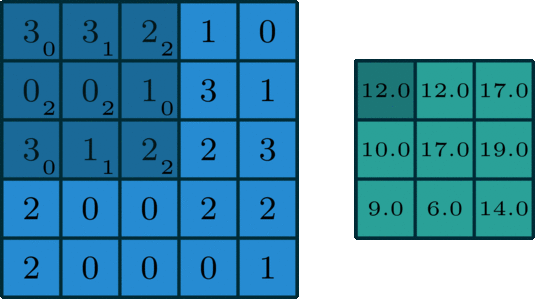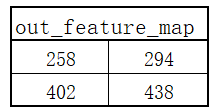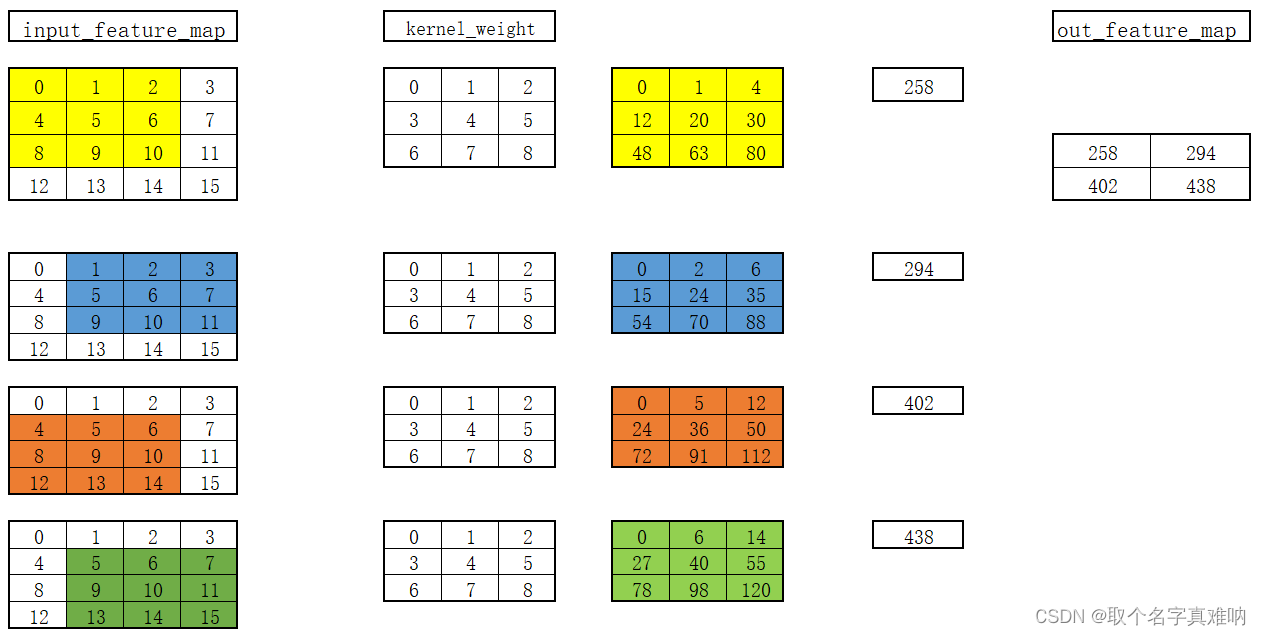22集 - 卷积基础原理与PyTorch卷积API基础功能介绍
22.1 卷积的操作

22.2 手动计算
- 定义输入矩阵:

- 定义卷积核权重矩阵

- 通过卷积计算可以得到一个输出矩阵

- 具体计算过程如下

22.3 代码测试
import torch
from torch import nn
from torch.nn import functional as F
input_feature_map = torch.arange(16,dtype=torch.float).reshape((1,1,4,4))
in_channel = 1
out_channel =1
kernel_size = 3
kernel_weight = torch.arange(9,dtype=torch.float).reshape(1,1,3,3)
my_conv2d = nn.Conv2d(in_channels=in_channel,out_channels=out_channel,kernel_size=kernel_size,bias=False)
my_conv2d.weight = nn.Parameter(kernel_weight,requires_grad=True)
output_feature_map = my_conv2d(input_feature_map)
functional_output_feature_map = F.conv2d(input_feature_map,kernel_weight)
print(f"input_feature_map={input_feature_map}")
print(f"input_feature_map.shape={input_feature_map.shape}")
print(f"my_conv2d.weight={my_conv2d.weight}")
print(f"my_conv2d.weight.shape={my_conv2d.weight.shape}")
print(f"output_feature_map={output_feature_map}")
print(f"output_feature_map.shape={output_feature_map.shape}")
print(f"functional_output_feature_map={functional_output_feature_map}")
print(f"functional_output_feature_map.shape={functional_output_feature_map.shape}")
input_feature_map=tensor([[[[ 0., 1., 2., 3.],
[ 4., 5., 6., 7.],
[ 8., 9., 10., 11.],
[12., 13., 14., 15.]]]])
input_feature_map.shape=torch.Size([1, 1, 4, 4])
my_conv2d.weight=Parameter containing:
tensor([[[[0., 1., 2.],
[3., 4., 5.],
[6., 7., 8.]]]], requires_grad=True)
my_conv2d.weight.shape=torch.Size([1, 1, 3, 3])
output_feature_map=tensor([[[[258., 294.],
[402., 438.]]]], grad_fn=<ThnnConv2DBackward>)
output_feature_map.shape=torch.Size([1, 1, 2, 2])
functional_output_feature_map=tensor([[[[258., 294.],
[402., 438.]]]])
functional_output_feature_map.shape=torch.Size([1, 1, 2, 2])
- 我们通过手动计算的输出矩阵和代码计算得到的矩阵结果一致;
23集 - 基于矩阵滑动相乘逐行实现PyTorch二维卷积
import torch
from torch import nn
from torch.nn import functional as F
import math
input_feature_map = torch.arange(16, dtype=torch.float).reshape((1, 1, 4, 4))
in_channel = 1
out_channel = 1
kernel_size = 3
kernel_weight = torch.arange(9, dtype=torch.float).reshape(1, 1, 3, 3)
my_conv2d = nn.Conv2d(in_channels=in_channel, out_channels=out_channel, kernel_size=kernel_size, bias=False)
my_conv2d.weight = nn.Parameter(kernel_weight, requires_grad=True)
output_feature_map = my_conv2d(input_feature_map)
functional_output_feature_map = F.conv2d(input_feature_map, kernel_weight)
print(f"input_feature_map={input_feature_map}")
print(f"input_feature_map.shape={input_feature_map.shape}")
print(f"my_conv2d.weight={my_conv2d.weight}")
print(f"my_conv2d.weight.shape={my_conv2d.weight.shape}")
print(f"output_feature_map={output_feature_map}")
print(f"output_feature_map.shape={output_feature_map.shape}")
print(f"functional_output_feature_map={functional_output_feature_map}")
print(f"functional_output_feature_map.shape={functional_output_feature_map.shape}")
my_input_matrix = torch.arange(16, dtype=torch.float).reshape(4, 4)
my_kernel = torch.arange(9, dtype=torch.float).reshape(3, 3)
def matrix_multiplication_for_conv2d(input, kernel, stride=1, padding=0,bias=0):
if padding > 0:
input = F.pad(input, (padding, padding, padding, padding))
input_h, input_w = input.shape
kernel_h, kernel_w = kernel.shape
output_h = math.floor((input_h - kernel_h) / stride + 1)
output_w = math.floor((input_w - kernel_w) / stride + 1)
output_matrix = torch.zeros(output_h, output_w)
for i in range(0, input_h - kernel_h + 1, stride):
for j in range(0, input_w - kernel_w + 1, stride):
region = input[i:i + kernel_h, j: j + kernel_w]
output_matrix[int(i / stride), int(j / stride)] = torch.sum(region * kernel)+bias
return output_matrix
my_output = matrix_multiplication_for_conv2d(my_input_matrix, my_kernel)
print(f"my_output={my_output}")
print(f"判断自定义函数得到的结果是否跟pytorch计算结果一致\n{torch.isclose(my_output,torch.squeeze(functional_output_feature_map))}")
my_input_new = torch.randn(5,5)
my_kernel_weight = torch.randn(3,3)
my_kernel_bias = torch.randn(1)
my_ouput_new = torch.squeeze(F.conv2d(my_input_new.reshape(1,1,5,5),weight=my_kernel_weight.reshape(1,1,3,3),
bias=my_kernel_bias,stride=2,padding=2))
my_ouput_fun = matrix_multiplication_for_conv2d(my_input_new,my_kernel_weight,stride=2,padding=2,bias=my_kernel_bias)
print(f"my_ouput_new={my_ouput_new}")
print(f"my_ouput_fun={my_ouput_fun}")
print(torch.isclose(my_ouput_new,my_ouput_fun))
input_feature_map=tensor([[[[ 0., 1., 2., 3.],
[ 4., 5., 6., 7.],
[ 8., 9., 10., 11.],
[12., 13., 14., 15.]]]])
input_feature_map.shape=torch.Size([1, 1, 4, 4])
my_conv2d.weight=Parameter containing:
tensor([[[[0., 1., 2.],
[3., 4., 5.],
[6., 7., 8.]]]], requires_grad=True)
my_conv2d.weight.shape=torch.Size([1, 1, 3, 3])
output_feature_map=tensor([[[[258., 294.],
[402., 438.]]]], grad_fn=<ThnnConv2DBackward>)
output_feature_map.shape=torch.Size([1, 1, 2, 2])
functional_output_feature_map=tensor([[[[258., 294.],
[402., 438.]]]])
functional_output_feature_map.shape=torch.Size([1, 1, 2, 2])
my_output=tensor([[258., 294.],
[402., 438.]])
判断自定义函数得到的结果是否跟pytorch计算结果一致
tensor([[True, True],
[True, True]])
my_ouput_new=tensor([[-1.2405, -0.9159, -1.1279, -1.0144],
[-3.2825, 0.0432, -0.3291, 0.2662],
[ 0.0200, 2.7674, 1.8148, -1.2932],
[-1.3802, -2.4980, -1.6681, -1.0186]])
my_ouput_fun=tensor([[-1.2405, -0.9159, -1.1279, -1.0144],
[-3.2825, 0.0432, -0.3291, 0.2662],
[ 0.0200, 2.7674, 1.8148, -1.2932],
[-1.3802, -2.4980, -1.6681, -1.0186]])
tensor([[True, True, True, True],
[True, True, True, True],
[True, True, True, True],
[True, True, True, True]])













 该文详细介绍了卷积的基础原理,并通过手动计算与PyTorch的`nn.Conv2d`及`F.conv2d`函数进行了对比,展示了如何使用矩阵滑动相乘实现二维卷积,同时验证了自定义函数计算结果与PyTorch计算结果的一致性。
该文详细介绍了卷积的基础原理,并通过手动计算与PyTorch的`nn.Conv2d`及`F.conv2d`函数进行了对比,展示了如何使用矩阵滑动相乘实现二维卷积,同时验证了自定义函数计算结果与PyTorch计算结果的一致性。














 759
759

 被折叠的 条评论
为什么被折叠?
被折叠的 条评论
为什么被折叠?








